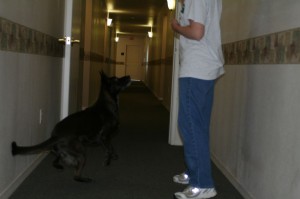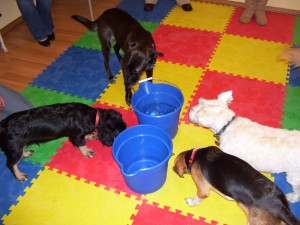Finally, the lightbulb went off. I spoke to several online friends who had experienced similar behaviors with their dogs. One recommended I read Fiesty Fido by Patricia McConnell. I ordered it immediately and started trying to implement some of her suggestions. Another suggested Scaredy Dog by Ali Brown. As soon as I started reading the lightbulb went on. Risa acted out the way she did because she was afraid. It was so obvious I couldn’t believe I hadn’t realized it sooner. Risa was afraid. She lashed out at other dogs because she was terrified and wanted them to stay away. In an instant, I no longer felt angry and frustrated with her. I felt pity. I had no idea she was so scared. My mindset in regards to her abhorrent behavior changed. That alone, made things better.
That’s not to say Risa’s behavior made an instant turnaround. Far from it. We weren’t even a year into our journey. But my attitude changed. I became more proactive because I knew she just wanted other dogs to stay away. I no longer got angry when she lashed out. I finally understood the why.
So I started taking her off the walking path and putting her in a sit FAR from the passing dog. Unfortunately, this was also unsuccessful. Having her sit seemed to give her more time to load up and then release her fear in a lunging fury. Even when there was distance between her and the other dog, it still wasn’t enough.
I implemented turn arounds but they didn’t help much either. Sure, we got away from the other dog but there was no easy way to get back the way we were going. Most of the places we walked were sort of uni-directional. Plus it was only a band-aid. It still didn’t address the problem.
I had realized early on in our time together that Risa was more attentive at high speeds. So I started running past other dogs with her (she was on the opposite side of me from the dog for safety). While this did decrease the amount of time she had to be close to the other dog and gave her a bit of an outlet in regards to her stress, it didn’t stop the reactions. Not to mention I felt silly doing it and it had the potential to overstimulate the dog we were passing. Having another reactive dog going off while I was trying to rehabilitate mine was not something I had planned on attempting yet.

Living in an apartment was like a living hell for a reactive dog. There was no way to get away from the possibility of seeing other dogs. Especially in tight spaces!
One of the things mentioned in Scaredy Dog (and many other reactive dog rehabilitation books) that I was unable to try was isolating your dog from her stressors for 2 weeks. It was simply impossible. I lived on the third floor of an apartment building filled with other dogs. No matter what time I took her out to potty, it was highly likely we’d run across a dog. Risa was also an extremely active 3-year old who needed long walks and lots of activity. Something I couldn’t give her indoors. Whether outside in the courtyard or in the cramped hallways. I couldn’t avoid her triggers. I couldn’t let her body’s stress levels go back to zero. I was forced to work with her as is.
I took her to Petsmart and rewarded her for looking at me instead of reacting to other dogs. I started turning and walking away if she got over threshold rather than just standing there and letting her have a meltdown. But I still wasn’t getting the success I wanted. She still became a spinning, barking, lunging fool at the sight or sound of other dogs. Dogs walking across the street. Dogs barking at her from balconies at our apartment complex. Dogs waiting outside the elevator that I didn’t even know were there until she exploded. I still hadn’t found the answer.
When she lunged at other dogs during classes, I put her in time outs. I would remove her from the situation and ask her for a down/stay. After a couple minutes, I would release her and we’d go back to whatever we were doing. While this may work for some dogs, it did nothing to help Risa. Not to mention it caused me great frustration which, as we all know, is problematic when it comes to dog training.
I kept reading more and more about how to work with dog reactivity. I came upon a new idea from a person who follows drive training. A way for me to be an outlet for Risa’s pent up stress and frustrations. I made a small tug toy out of fleece and started bringing it with me on walks. When we saw another dog, I asked her to play tug with me. We’d play tug as we walked past the other dog. I always made sure Ris’ leash was short and that we were far away from the other dog. I saw some progress with this method but it had its faults. Firstly, Risa will not play in a location that is too stressful. Secondly, she is a resource guarder around other dogs so I had to be careful. Thirdly, there were times she would let go of the tug and lunge at the other dog anyway (which is why I kept the leash short!). Finally, a tugging dog can be too arousing for other dogs watching which I didn’t think was fair to the other handler. We still needed to find a proper, workable solution. . .
